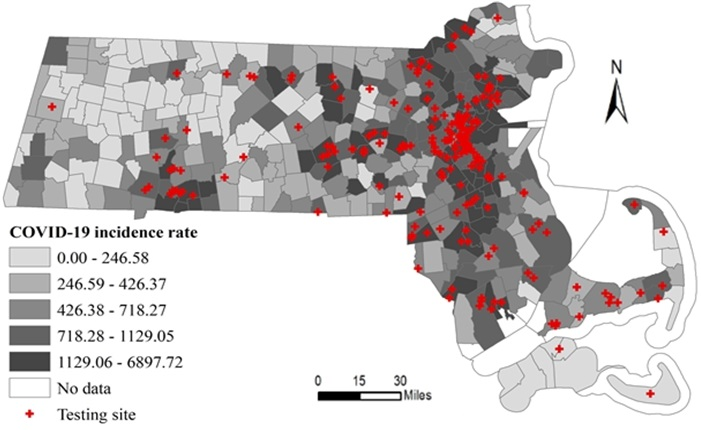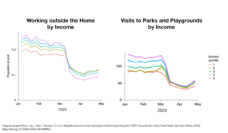
Figure 1. Covid-19 incidence rate and testing sites spatial distributions in cities/towns of Massachusetts as of May 20, 2020.
Since the beginning of April 2020, the US has become the center of the Covid-19 pandemic, and the number of cases is still increasing. Social inequities and injustice have been highlighted in the pandemic, especially the racial disparities in transmission, hospitalization, and death. For example, across the country, deaths caused by Covid-19 are disproportionately high among African Americans. Socioeconomic inequities and systemic racism frequently impact health and health care access, resulting in a higher burden of disease and mortality in Black, Hispanic, and other vulnerable communities.
My colleagues and I investigated associations between racial segregation, health care access, and Covid-19 infection rates in Massachusetts. We examined the racial segregation of Hispanic, Non-Hispanic Black, and Asian Americans, and mapped the spatial access to testing sites and hospitals.
We found that the Non-Hispanic Black population had the shortest drive time to testing sites (5.69 minutes), followed by Hispanic (5.92 minutes), Asian (6.19 minutes), and Non-Hispanic White (7.82 minutes). Access to hospitals showed similar results, with a minor difference: Hispanic residents surpassed the Non-Hispanic Black population with the lowest travel time. White residents still had the longest travel times of 11.21 min to hospitals. In comparison, the travel times to testing sites were almost three minutes shorter than the travel times to hospitals.
In terms of Covid-19 incidence, our spatial models show that Hispanic and Black communities have been most vulnerable to viral transmission. This increased risk for infection is associated with housing segregation, as many Black and Hispanic residents of Massachusetts live in poor areas characterized by high housing densities. For example, we found a strongly significant and positive relationship between Covid-19 incidence and the percentage of occupied housing units with more than one occupant per room. Such housing density makes social distancing, quarantine, and isolation difficult or impossible.
This increased risk for infection is associated with housing segregation, as many Black and Hispanic residents of Massachusetts live in poor areas characterized by high housing densities.
We also looked for associations between Covid-19 incidence rate and the proportion of older people in a city/town and found no statistical significance. This may be attributable to the geographical distribution of the senior citizens in Massachusetts. Cities and towns with high percentages of the elderly population are mainly located in the west and eastern coastal areas, which are far from the Greater Boston area.
Overall, our findings provide helpful insights and guidance for policymakers to develop public health strategies to contain Covid-19 transmissions within Massachusetts. Our geospatial research framework and findings offer individual states an important methodology for better understanding Covid-19 transmission in the context of their unique community factors, including racial and socioeconomic distribution and travel infrastructure.














